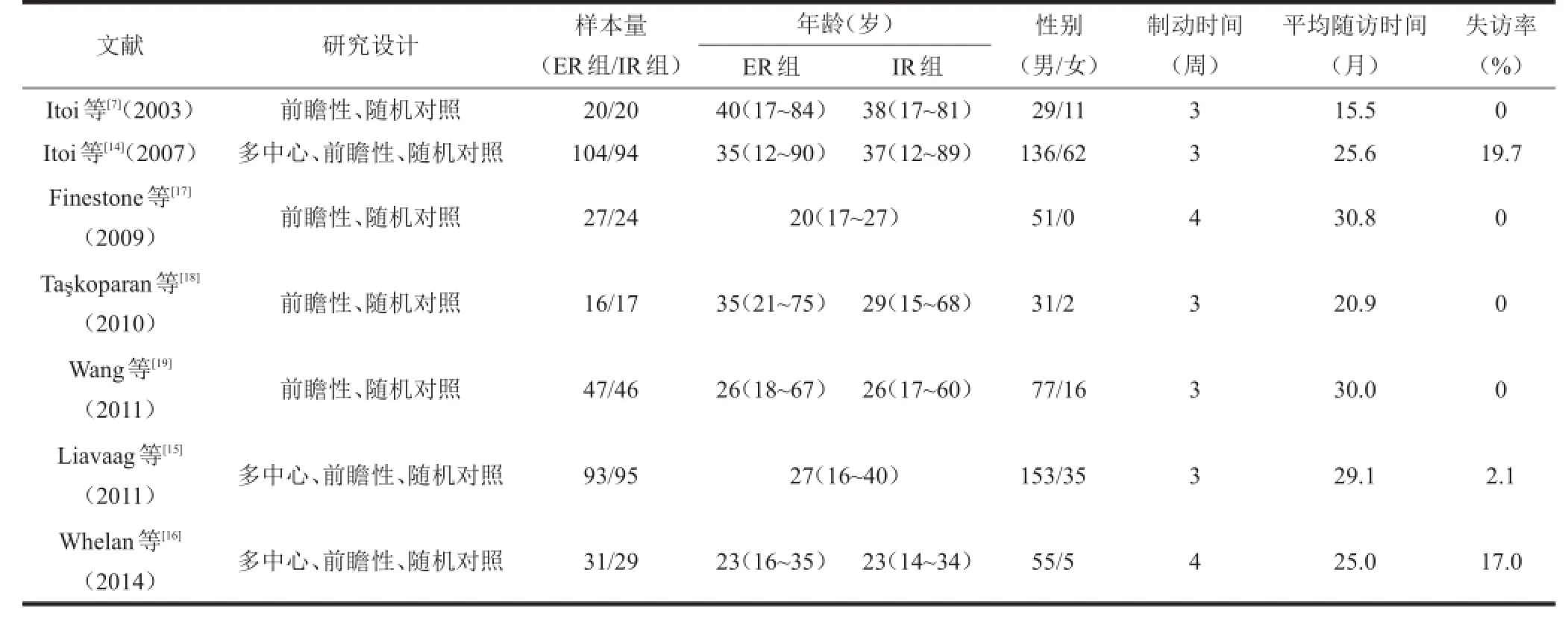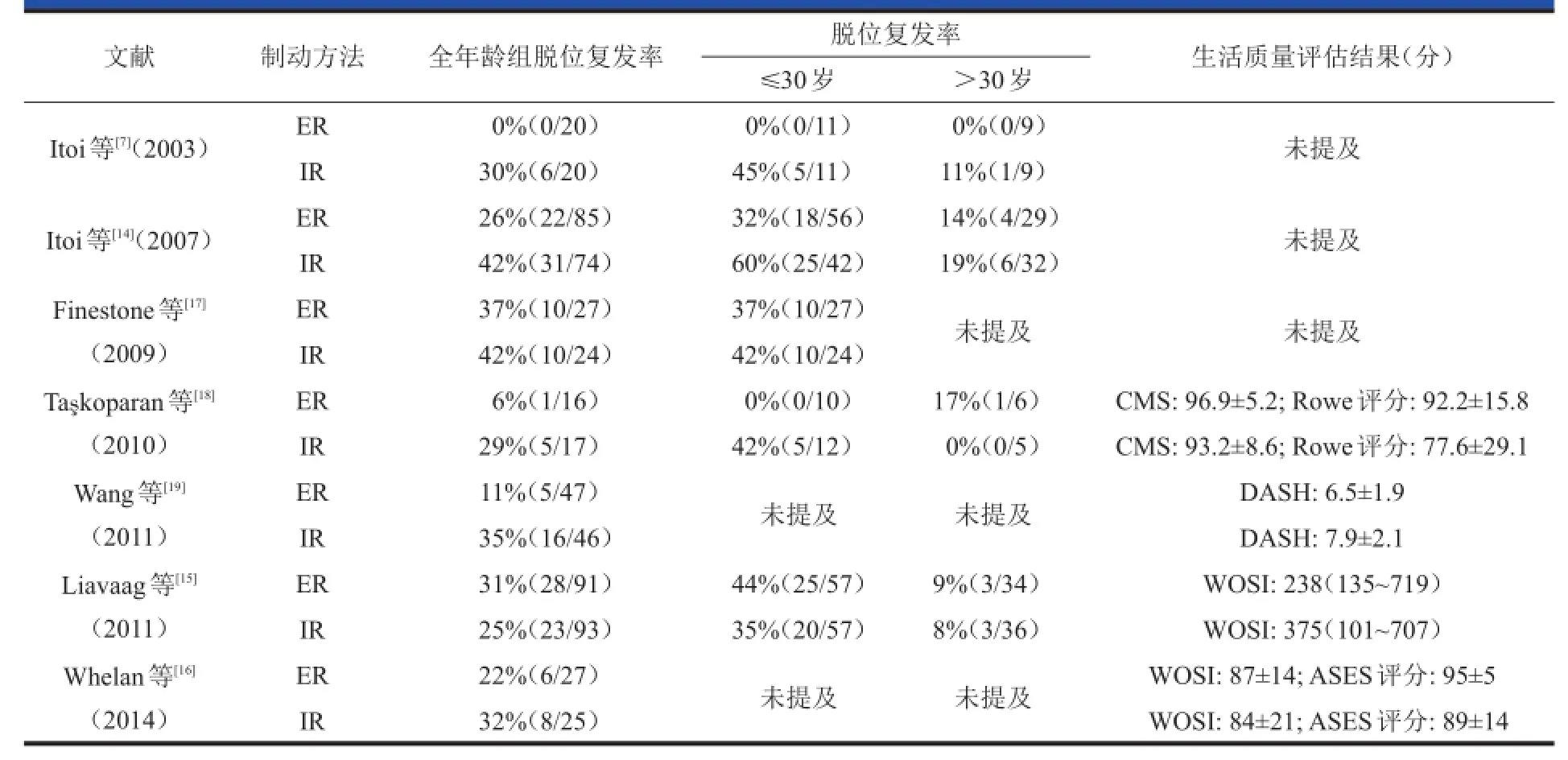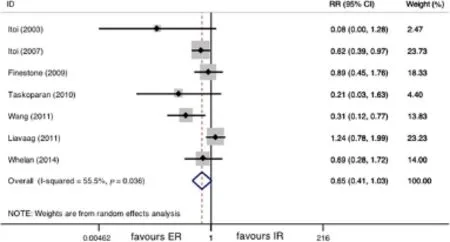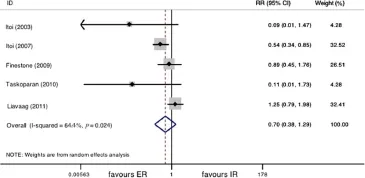制动方法对初发肩关节脱位术后脱位复发率和生活质量改善情况的荟萃分析
马驰原 刘安 严世贵
(浙江大学医学院附属第二医院骨科,杭州310009)
制动方法对初发肩关节脱位术后脱位复发率和生活质量改善情况的荟萃分析
马驰原 刘安 严世贵*
(浙江大学医学院附属第二医院骨科,杭州310009)
背景:肩关节脱位损伤是常见的肩关节损伤,其中以肩关节前脱位为主。初发肩关节脱位保守治疗中,手法复位后选择外旋位制动还是内旋位制动一直存有争议。
目的:用荟萃分析的方法比较初次肩关节脱位后外旋制动和内旋制动对脱位复发率和患者生活质量的影响。
方法:电子检索PubMed、EMBASE、Cochrane图书馆、Web of Science数据库,收集直接对比初次肩关节脱位后肩关节外旋和内旋制动术后脱位复发率和患者生活质量的随机对照研究(RCT)。对纳入的文献进行质量分析和资料提取后使用STATA 11.0软件进行数据处理。
结果:纳入RCT研究7篇,患者663例,外旋制动组338例,内旋制动组325例。数据分析显示,外旋制动组与内旋制动组相比,所有年龄组别中的脱位复发率均无统计学差异,总体组别(RR=0.65,95%CI 0.41~1.03,P=0.067),30岁以下组别(RR=0.70,95%CI0.38~1.29,P=0.250),30岁以上组别(RR=0.86,95%CI0.38~1.97,P=0.722)。4篇RCT比较了两种制动方式术后的患者生活质量,其中只有1篇RCT显示两种制动方式术后外旋制动组生活质量更优且有统计学差异,其他3篇RCT均表明术后患者生活质量无统计学差异。
结论:根据本研究的结果,与内旋制动相比,外旋制动在降低初次肩关节脱位术后的脱位复发率和提高患者的术后生活质量方面均无明显优势。
制动;外旋位;内旋位;初次肩关节脱位;荟萃分析
Background:ound:Shoulder dislocations,especially anterior shoulder dislocation,are common injuries in our daily life.But the choiceof external rotation or internal rotation immobilization remains controversial.
Objective:tive:To evaluate the rate of recurrence and patient-based quality-of-life afterexternal rotation(ER)versus internal rotation(IR)immobilization in primary anterior shoulder dislocation by ameta-analysis.
Methods:hods:The PubMed,EMBASE,Cochrane Library and ISIWeb of Sciencewere searched up to January 2013,using the Boolean operators as follows:(Bankart lesion OR shoulder anterior dislocation)AND(external rotation AND internal rotation OR immobilization).A ll prospective random ized controlled trials(RCTs)directly com paring recurrence rate and patient-based quality-of-lifebetween ER and IR immobilizationwere retrieved.Alldatawere conductedw ith STATA 11.0.
Results:ults:Seven RCT studies involving 663 patients(338 in ER group and 325 in IR group)were included in themeta analysis.No significant difference w as observed in the recurrence rate in different age groups(in all patients:risk ratio[RR]= 0.65,95%confidence interval[CI]:0.41-1.03,P=0.067;in the patients aged less than 30 years:RR=0.70,95%CI:0.38-1.29,P=0.250;in the patientsagedmore than 30 years:RR=0.86,95%CI:0.38-1.97,P=0.722).In four trialsassessing quality-of-lifeafter ER or IR immobilization,only one demonstrated borderline statisticalsignificance(P=0.05)and probable superiority of the ER group based on theASES.No significantdifferencewasobserved in other three trials.
Conclusions:ions:Based on the results of ouranalysis,the ER immobilization cannot reduce the ratesof recurrenceafter primary anterior shoulder dislocation or improve thequality of life comparedw ith the IR immobilization.
肩关节前脱位损伤是常见的肩关节损伤[1]。有统计报道称,美国急诊患者中肩关节脱位的发生率是0.239‰[2]。传统的手法复位后患肢内旋位悬吊制动是主要方法,已有2000多年历史[3],但仍有一定的复发率[4,5]。Bankart损伤是肩关节前脱位的伴发损伤,该损伤造成肩关节习惯性前方不稳定,与脱位的复发具有一定相关性,因此有研究采用肩关节手法复位后外旋位制动以利于Bankart损伤的修复[6],并已有早期的前瞻性研究表明,肩关节外旋位制动相比于内旋位制动可降低肩关节脱位的复发率,有统计学意义[7]。但其后的多个前瞻性研究并不支持上述观点。对两篇前瞻性研究进行的回顾性研究认为,外旋位制动与内旋位制动相比,在降低脱位复发率上可能更有优势,但并无统计学差异[8]。此外,许多患者虽然没有复发脱位,但是内旋位制动后肩关节的不稳定和疼痛严重影响了患者的生活质量。因此,患者生活质量评价体系应该被纳入今后肩关节脱位后制动治疗的考虑范围,包括西安大略肩关节不稳定指数(Western Ontario shoulder instability index, WOSI)[9],美国肩肘外科协会(the American Shoulder and Elbow Surgeons,ASES)评分[10],Rowe评分[11]和Constant-Murley评分(Constant-Murleyscore,CMS)[12]。
本研究旨在通过回顾前瞻性随机对照研究(random ised controlled trials,RCT)比较初次肩关节脱位后外旋制动和内旋制动对脱位复发率和患者生活质量的影响。
1 资料与方法
1.1 检索策略
电子检索PubMed,EMBASE,Cochrane图书馆,Web of Science和中国知网数据库,收集2014年1月以前发表的直接比较初次肩关节脱位后外旋位和内旋位制动术后脱位复发率和患者生活质量的RCT研究。手工检索中文骨科期刊的相关文献。文献检索无语种限制。英文检索词:bankart lesion;shoulder anterior dislocation;external rotation;internal rotation;immobilisation。中文检索词:Bankart损伤,肩关节脱位,外旋,内旋,制动。
1.2 纳入和排除标准
纳入标准:①直接比较2种制动方式的脱位复发率或术后生活质量;②研究对象既往无肩关节脱位病史;③随访时间超过1年;④前瞻性随机对照研究。排除标准:①非前瞻性随机对照研究;②尸体研究;③结果数据不可用;④随访时间少于1年。
1.3 数据提取
提取的主要研究数据包括:研究设计、样本特征(样本量、年龄、性别比例等)、制动时间、平均随访时间、失访率、脱位复发率和术后生活质量评估结果。对文献中未提供的数据,尽量和研究者取得联系并获取相关数据。
1.4 文献质量评价
由两位研究者独立对研究进行评价,如有分歧,则征求第3位研究者的意见。评价标准共12条[13]:①受试者分组是否随机;②随机方案是否隐藏;③对患者是否使用了盲法;④实验干预时对实验者是否使用了盲法;⑤术后评估时对评估者是否使用了盲法;⑥失访率是否在可接受的范围;⑦是否采用意向分析法(intention-to-treat,ITT)分析结果;⑧是否避免选择性偏激描述;⑨组间基线是否相似;⑩除了实验变量外的其余变量是否相似或者尽量避免;○11患者依从性如何;○12时间是否相似。对研究进行Kappa一致性检验。
1.5 统计学处理
使用STATA 11.0软件对数据进行统计学分析。二分类数据计算相对危险度(relative risk,RR)和95%置信区间(confidence interval,CI)。连续变量如采用同一标准测量时计算加权平均差(weighted mean difference,WMD)或标准平均差(standardised mean difference,SMD)以及95%CI。数据的异质性应用卡方检验及I2检验。I2<50%认为数据异质性较低,采用固定效应模型;反之,采用随机效应模型。使用GRADE(the grading of recommendations assessment,developmentand evaluation)评价方法对分析结果进行证据等级评价[20]。
2 结果
2.1 文献纳入结果
初步检索到896篇文献,经阅读标题及摘要,排除重复发表、同一作者累计发表的文献,初步纳入14篇文献。14篇中2篇不是对照研究,5篇无超过1年的随访数据,最终纳入7篇文献[7,14-19](图1)。对纳入文献方法学评价,高质量3篇[14-16],中等质量4篇[7,17-19](表1)。对研究进行Kappa一致性检验,Kappa值为0.86(95%CI0.78~0.92),一致性良好。7篇文献共纳入663例患者,其中外旋位制动组(external rotation, ER)组338例,内旋位制动组(internal rotation,IR)组
325例,男女比例为532:131,制动时间都控制在3~4周,平均随访时间均超过15.5个月,所有研究的失访率都控制在20%以内。7篇文献所采用样本基线数据详见表2。

图1 Meta分析文献筛选流程
2.2 脱位复发率
纳入文献均对脱位复发率进行了随访(表3)。其中4篇文献表明,ER与IR相比,降低脱位复发率(P<0.05)[7,14,18,19]。另外3篇文献表明两者间并无统计学差异[15-17]。对7篇文献的所有实验数据进行了荟萃分析,对不同组别进行异质性检验,全年龄组(I2= 55%)和30岁以内年龄组(I2=64%)有中等异质性。故对全年龄组和30岁以内年龄组采用随机效应模型进行分析,对30岁以上年龄组采用固态效应模型进行分析。分析结果显示,ER组与IR组相比,全年龄组别的脱位复发率无统计学差异(n=612,RR=0.65, 95%CI 0.41~1.03,P=0.067,图2),30岁以下年龄组(n=307,RR=0.70,95%CI0.38~1.29,P=0.250,图3)和30岁以上年龄组(n=160,RR=0.86,95%CI0.38~1.97, P=0.722,图4)亦无统计学差异。

表1 纳入文献的方法学质量评估

表2 受试数据

表3 脱位复发率和生活质量评估结果
2.3 生活质量评估
有4篇文献[15,16,18,19]对患者术后生活质量进行了随访(表3)。其中生活质量评估体系包括ASES,WOSI,上肢功能调查量表(the disabilities of arm,shoulder and hand,DASH)[21],Rowe评分和CMS。Whelan等[16]的研究表明在基于ASES评分体系的生活质量评估中ER组要优于IR组,而其余研究均表明在随访时间内两组生活质量无统计学差异。由于其余的3篇文献[15,18,19]均未对两组的生活质量基线进行评估,且各个研究使用了不同的生活质量评估体系,所以未对生活质量评估进行合并分析。
2.4 等级评价
根据GRADE评价方法,由于没有做到充分的盲法和缺乏具体的入选标准,ER组和IR组数据在不同文献之间有明显异质性,全年龄组和30岁以内年龄组的证据等级为低,30岁以上年龄组的证据等级为中等。
3 讨论
Itoi等[7]首先关注并通过随机对照研究阐释了初次肩关节前脱位后外旋位制动在降低脱位复发率方面的优势。其后,越来越多的骨科医师开始将ER作为初次肩关节前脱位后的首选制动方式。但其后的数个临床研究并未得到一致的结论[14-19]。本研究纳入的文献证据等级为1级或2级。所有脱位复发的数据均按照年龄(以30岁为界)进行分层处理,以比较两种制动方法在降低脱位复发率方面的优劣。其次,本研究纳入了生活质量评估数据来评估治疗后患者生活质量和生活幸福感。根据本研究的分析结果,与IR相比,初次肩关节脱位后ER在降低脱位复发和提高患者生活质量方面并无明显优势。
同时,最佳的ER角度也一直存有争议。M iller等[22]通过对尸体的生物力学研究发现,相较于IR,外旋45°位制动更有利于增加Bankart损伤部位的接触力,从而促进Bankart损伤的愈合。有研究通过肩关节镜评估提出最优的制动位置为上臂制动于外旋60°并外展30°[23]。本研究纳入的文献中采用的ER位置为5°~20°。此外,患者在至少3周的制动治疗期间的生活质量也是必须兼顾到的方面,而外旋角度的增加会导致患者在接受治疗期间的不适并且影响依从性。
年龄一直被研究者们作为主要的再脱位危险因素。有文献报道,初次肩关节脱位后脱位复发率在30岁以下人群明显高于30岁以上人群[24-26]。所以本研究在降低脱位复发率方面将30岁作为分界点来评估ER在年轻患者中的表现是否优于IR,但结果是两组间并无统计学差异。甚至依从性好的士兵患者的对比研究也未提示明显差异[17]。Bankart损伤常合并Hill-Sachs损伤[27],年轻患者中的肩关节脱位很大一部分都是由运动外伤引起[28],并且肩关节运动外伤常合并肩袖损伤[29]。Hill-Sachs损伤和肩袖损伤都会影响肩关节稳定性,从而影响术后脱位复发率,与制动方法关系不大。

图2 全年龄层ER组与IR组脱位复发率比较

图3 30岁以下年龄层ER组与IR组脱位复发率比较

图4 30岁以上年龄层ER组与IR组脱位复发率比较
在初发肩关节脱位术后生活质量方面。Whelan等[16]的研究表明ER组的ASES评分比IR组高6分,且有统计学差异。但有研究表明,ASES的最小临床重要差异(m inimal clinically importantdifference,MCID)是6.4分[10,30]。而Whelan等[16]的研究结果并未达到MCID。因此认为,在ASES评分体系中,ER并不优于IR。此外,初发肩关节脱位术后患者的评估侧重点应是肩关节的稳定性[31],而作为一个被广泛使用的肩关节功能评价体系,CMS中很大一部分是肩关节的活动度(40%)和肌力(25%)。所以,对肩关节前脱位患者,目前尚缺乏更科学合理的评分体系。
本研究的不足包括:①纳入的3篇文献运用奇偶数或入院编号进行随机分组的方法不当,会造成偏倚从而降低文献的质量。②不同研究的患者依从性不一致。如Finestione等[17]的研究对象为士兵,依从性好,而Liavaag等[15]的研究对象来自多个中心,依从性差异大。③纳入研究的随访时间较短,所选取文献的平均随访时间为2年。虽然已有文献表明大多数脱位复发患者的再脱位都发生在初次脱位后2年内[32,33],但较长的随访时间更有助于评估初次肩关节脱位后不同制动方式的治疗效果。④缺乏基线生活质量评估。如果两组间的基线生活质量评分相同或相似,将有助于获得更可靠的生活质量评估结果。
综上,在初次肩关节脱位后,外旋位制动与内旋位制动相比在理论上有利于Bankart损伤的修复,但在降低脱位复发率和提高术后患者生活质量方面并无明显优势。
[1]Halder AM,Itoi E,An KN.Anatomy and biomechanics of the shoulder.Orthop Clin North Am,2000,31(2):159-176.
[2]ZacchilliMA,Owens BD.Epidem iology of shoulder dislocations presenting to emergency departments in the United States.JBone JointSurg Am,2010,92(3):542-549.
[3]Hippocrates.Injuries of the shoulder Dislocations.Clin Orthop RelatRes,1989,(246):4-7.
[4]Hovelius L,Olofsson A,Sandström B,et al.Nonopera-tive treatment of primary anterior shoulder dislocation in patients forty years of age and younger.A prospective twentyfive-year follow-up.J Bone Joint Surg Am,2008,90(5): 945-952.
[5]Kralinger FS,Golser K,Wischatta R,etal.Predicting recurrence after primary anterior shoulder dislocation.Am J SportsM ed,2002,30(1):116-120.
[6]Itoi E,Sashi R,M inagawa H,et al.Position of immobilization after dislocation of theglenohumeral joint.A study with use ofmagnetic resonance imaging.JBone Joint Surg Am, 2001,83-A(5):661-667.
[7]Itoi E,Hatakeyama Y,Kido T,etal.A new method of immobilization after traumatic anterior dislocation of the shoulder:a prelim-inary study.JShoulder Elbow Surg,2003,12 (5):413-415.
[8]PatersonWH,Throckmorton TW,Koester M,et al.Position and duration of immobilization after primary anterior shoulder dislocation:a systematic review andmeta-analysisof the literature.JBone JointSurgAm,2010,92(18):2924-2933.
[9]Kirkley A,Griffin S,M cLintock H,et al.The development and evaluation of a disease-specific quality of lifemeasurement tool for shoulder instability.The Western Ontario Shoulder Instability Index(WOSI).Am JSports M ed,1998, 26(6):764-772.
[10]M ichener LA,M cClure PW,Sennett BJ.American Shoulder and Elbow Surgeons Standardized Shoulder Assessment Form,patientself-reportsection:reliabil-ity,validity,and responsiveness.JShoulder Elbow Surg,2002,11(6):587-594.
[11]Rowe CR,Patel D,Southmayd WW.The Bankart procedure:a long-term end-result study.JBone Joint Surg Am, 1978,60(1):1-16.
[12]Constant CR,M urley AH.A clinicalmethod of functional assessment of the shoulder.Clin Orthop Relat Res,1987, (214):160-164.
[13]Furlan AD,Pennick V,Bombardier C,et al.2009 updated method guidelines for systematic reviews in the Cochrane Back Review Group.Spine(Phila Pa 1976),2009,34(18): 1929-1941.
[14]Itoi E,Hatakeyama Y,Sato T,etal.Immobilization in external rotation after shoulder dislocation reduces the risk of recurrence–a randomized controlled trial.JBone Joint Surg Am,2007,89(10):2124-2131.
[15]Liavaag S,Brox JI,Pripp AH,etal.Immobilization in external rotation after primary shoulder dislocation did not reduce the risk of recurrence:a randomized controlled trial.J Bone JointSurg Am,2011,93(10):897-904.
[16]Whelan DB,Litchfield R,Wambolt E,et al.External rotation immobili-zation for primary shoulder dislocation:a random ized controlled trial.Clin Orthop Relat Res,2014,472 (8):2380-2386.
[17]Finestone A,Milgrom C,Radeva-Petrova DR,et al.Bracing in external rotation for traumatic anterior dislocation of the shoulder.JBone JointSurg Br,2009,91(7):918-921.
[18]Taşkoparan H,Kılınçoğlu V,Tunay S,etal.Immobilization of the shoulder in external rotation for prevention of recurrence in acute anterior dislocation.Acta Orthop Traumatol Turc,2010,44(4):278-284.
[19]Wang DY,Zhang ZL,Zheng YZ,etal.Analysison the rotation angle and the effect of two immobilizationmethods after reduction of shoulder dislocation in emergency treatment.New Med,2011,42:221-224.
[20]Atkins D,Best D,Briss PA,et al.Grading quality of evidence and strength of recommendations.Br Med J,2004, 328(7454):1490.
[21]Kitis A,Celik E,Aslan UB,et al.DASH questionnaire for the analysis ofmusculoskeletal symptoms in industry workers:a validity and reliability study.Appl Ergon,2009,40(2): 251-255.
[22]M iller BS,Sonnabend DH,Hatrick C,et al.Should acute anterior dislocationsof the shoulderbe immobilized in external rotation?A cadaveric study.J Shoulder Elbow Surg, 2004,13(6):589-592.
[23]Hart WJ,Kelly CP.Arthroscopic observation of capsulolabral reduction after shoulder dislocation.J Shoulder Elbow Surg,2005,14(2):134-137.
[24]Hovelius L,Augustini BG,Fredin H,etal.Primary anterior dislocation of the shoulder in young patients.A ten-year prospective study.JBone Joint Surg Am 1996,78(11):1677-1684.
[25]K irk ley A,Griffin S,Richards C,et al.Prospective randomized clinical trial comparing the effectiveness of immediate arthro-scopic stabilization versus immobilization and rehabilitation in first trau-matic anterior dislocations of the shoulder.Arthroscopy,1999,9(15):507-5 14.
[26]te Slaa RL,Wijffels MP,Brand R,etal.The prognosis following acute primary glenohumeral dislocation.J Bone JointSurg Br,2004,86(1):58-64.
[27]Provencher MT,Frank RM,Leclere LE,et al.The Hill-Sachs lesion:diagnosis,classification,and management.J Am Acad Orthop Surg,2012,20(4):242-252.
[28]Owens BD,Agel J,Mountcastle SB,etal.Incidence of glenohumeral instability in collegiate athletics.Am J Sports M ed,2009,37(9):1750-1754.
[29]Auplish S,Funk L.Rotator cuff tears in athletes.Br JHosp Med(Lond),2009,70(5):271-275.
[30]Sm ith MV,CalfeeRP,Baumgarten KM,etal.Upperextrem ity-specificmeasures of disability and outcomes in orthopaedic surgery.JBone JointSurgAm,2012,94(3):277-285.
[31]Conboy VB,Morris RW,Kiss J,et al.An evaluation of the Constant–Murley shoulder assessment.JBone Joint Surg Br,1996,78(2):229-232.
[32]Rowe CR.Prognosis in dislocations of the shoulder.JBone JointSurg Am,1956,38-A(5):957-977.
[33]Robinson CM,Howes J,Murdoch H,et al.Functional outcome and risk of recurrent instability after primary traumatic anterior shoulder dislocation in young patients.J Bone JointSurg Am,2006,88(11):2326-2336.
External rotation immobilization doesnot reduce recurrence rateor improve quality of lifeafterprimary anteriorshoulderdislocation:the resultof ameta analysis
MAChiyuan,LIUAn,YAN Shigui*
(DepartmentofOrthopaedic Surgery,Second A ffiliated Hospital,SchoolofMedicine,Zhejiang University,Hangzhou310009,China)
ords:Immobilization;External rotation;Internal rotation;Primary anterior shoulder dislocation;M eta-analysis
2095-9958(2015)02-0 056-06
10.3969/j.issn.2095-9958.2015.01-011
*通信作者:严世贵,E-mail:zrjw sj@zju.edu.cn

